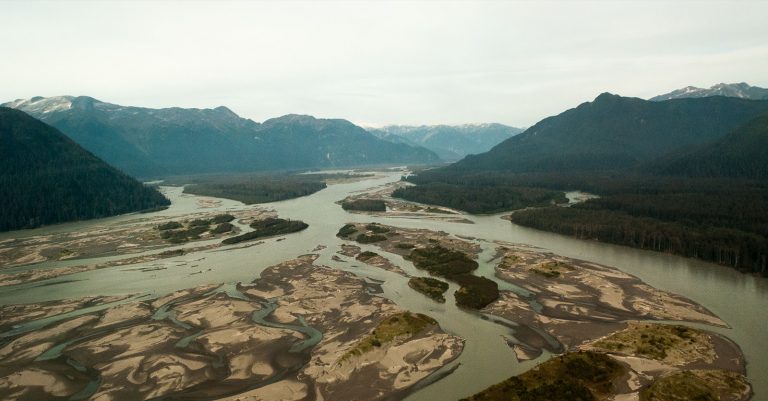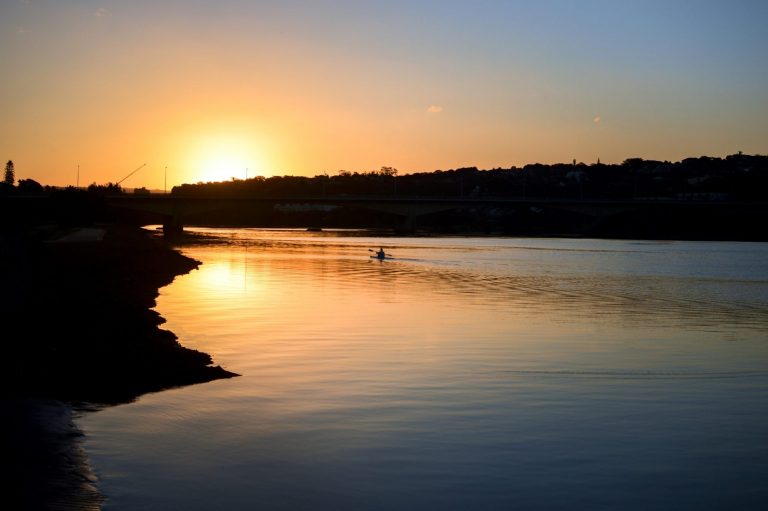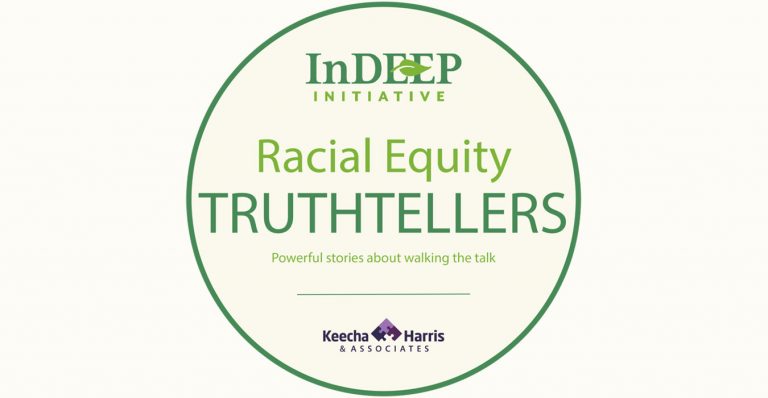Leaving With a Heart Full of Gratitude and a Head Full of Learnings
As many of you know, the McKnight Foundation is sunsetting our Mississippi River program in light of other strategic priorities. For 27 years, this program has worked to restore the water quality and ensure a clean river system for communities across the American heartland. We are incredibly proud of our partners and their progress toward a healthier and more resilient Mississippi River.
I like to think of myself as a long-standing member of McKnight’s Mississippi River program community. I’ve served as McKnight staff for seven years, and prior to that, received 10 years of project support from McKnight’s Mississippi River program grants to my previous employer, the Institute for Agriculture and Trade Policy. With the sunset of the river program, my colleague Julia Olmstead moved on from McKnight several weeks ago, and in mid-March, I will begin my new role as executive director at the Regenerative Agriculture Foundation.
While I hold the sadness of the Mississippi River program ending, I feel the joy of having been part of something bigger than any of us. We aspired to a ridiculously grand vision: to restore the health of this enormous Mississippi River system. The fourth-longest river in the world, the Mississippi drains part or all of 31 states—and in that context, our individual actions may mean little. Yet grantees and partners persisted by forging relationships with farmers and landowners, informing state and federal officials, participating in cleanups, expressing concerns to corporations, and educating voters and consumers.
“Today, farmers, environmentalists, and the general public are far more advanced in understanding the land and water connections, and we are managing water far better than in the past.”—MARK MULLER, MISSISSIPPI RIVER PROGRAM DIRECTOR
After the Mississippi River program’s 27 years of effort, which included 1,400 grants totaling more than $190 million, I can’t help but wonder how we did. While some of the well-known biological indicators, such as the sediment filling in Lake Pepin (continuing at a rapid pace) and the dead zone in the Gulf of Mexico (just as big as ever most summers), may not inspire much confidence, I’ve seen enormous progress in three decades.
In the early 1990s, I spent two summers conducting outreach to farmers about fertilizer and pesticide management. Rarely had those farmers made the connection between chemical use and downstream water supplies. Back then, wetlands were still often perceived as an annoyance on the landscape and most useful when drained. Rivers were thought most effective when channelized and moving water as quickly as possible.
Today, farmers, environmentalists, and the general public are far more advanced in understanding the land and water connections, and we are managing water far better than in the past. One of the positive outcomes from making a river healthier is that cities are once again turning toward riverfronts. Minneapolis, St. Paul, La Crosse, Dubuque, and St. Louis are a few of the cities that have been investing heavily in their Mississippi River waterfronts. Clean water begets more recreational activities, which get more people thinking about the river at the voting booth and the grocery store.
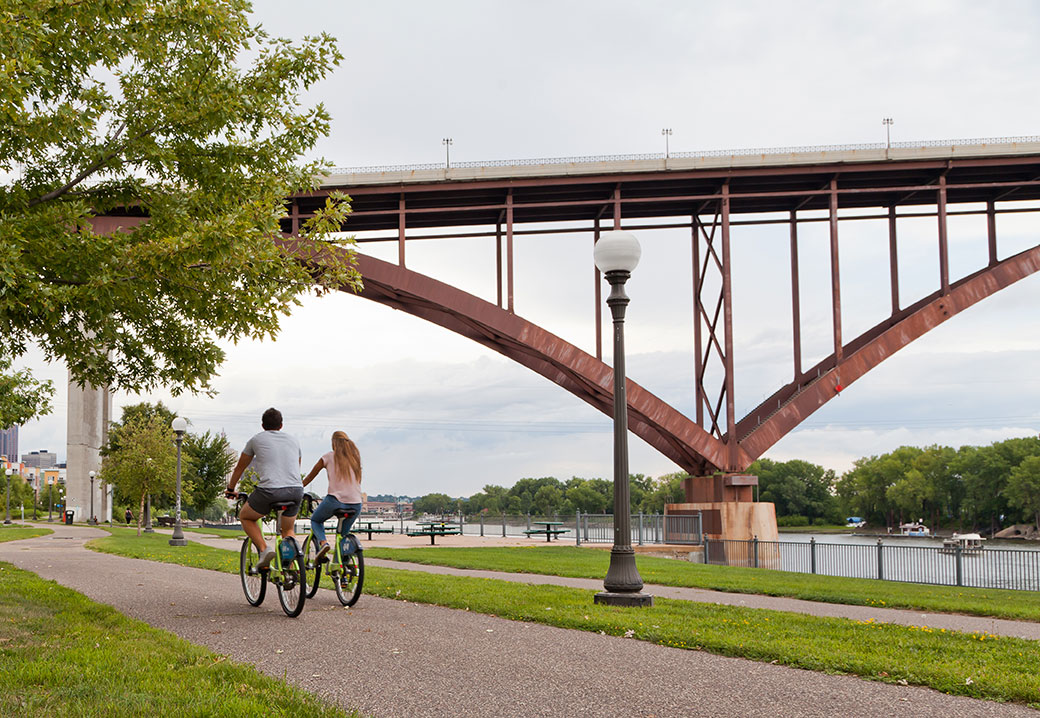
A couple riding bicycles along Mississippi River in St. Paul, MN. Photo credit: Bogdan Denysyuk/Shutterstock.com
Seven Lessons Learned
In the past several weeks, I’ve asked several McKnight grantees and partners to share their learnings from the nearly three decades of work. What has been successful, and what has not? Where has philanthropy been supportive, and where did we fall short? Following are some of the valuable insights that I learned.
1. Individual projects strive for change, but the larger goal is transformation. Know the difference between the two. Like many other family foundations, McKnight has made grants often covering a two-year period. This is, hopefully, adequate time to drive change—for example, the number of acres of a watershed in cover crops, or the number of legislators knowledgeable about a river-supporting policy. Yet the scale and timeframe of these projects are a drop in the bucket compared with the overall goals of the river program. The Gulf dead zone will be with us for many, many years, even if every landowner adopts regenerative practices and wetlands are restored all across the Midwest.
Funders have an opportunity to connect the dots between multiple on-the-ground projects and the larger goal of transformation. The challenge, however, is that it is easy to lose the forest for the trees. The benefits of a project promoting cover cropping, for example, are less about the specific number of adopted acres, and far more about lessons learned regarding effective incentive structures, technical assistance, and the messaging that can be incorporated into other projects. Besides financial support, funders have an often-overlooked role to facilitate the transfer of learning between grantees and partners.
And perhaps as importantly, funders need to understand and convey the difference between a project and the long-term goal of transformation. A cover cropping project can be addressed with a linear approach, by isolating a few variables and testing different methods of changing farmer behavior. If we do project X, then results Y will occur. Reducing the Gulf dead zone, on the other hand, is way beyond linear change and requires a transformational approach. For the dead zone and any transformational effort, project X can’t be expected to have any measurable impact on the ultimate goal of reducing nutrients to the Gulf and the size of the dead zone.
2. We too often dream of finding that silver bullet—a particular policy or outreach tool that will miraculously drive transformation. Silver bullets don’t exist in the real world. It would be better to think of project work as individual sandbags that collectively prevent flooding and drive transformational change. I have been as guilty of this thinking as anyone. I went through a stage in my career when I could trace most of the environmental and economic problems facing farming communities to inappropriate incentives and policies in the federal farm bill. “If people would listen to me and support these changes in the farm bill,” I thought, “then we would have a flourishing, regenerative agriculture as well as healthier diets and stronger rural economies!”
I see how policy advocacy is crucial for addressing these issues. But policy advocacy is not effective in isolation; it has to be fed with on-the-ground research and outreach, with organizing, with consideration of private sector interests that prefer the status quo, etc. And policy advocacy must be iterative and incorporate learnings—the economy, the environmental challenges, and the political environment are far different today than they were just a decade ago.
As a funder, I have spent too much time infatuated with projects I thought could be silver bullets. They are not. I could have instead provided more value by facilitating more interaction between a diversity of projects. If these projects could be thought of as sandbags that are not particularly useful in isolation but collectively can redirect floodwater, perhaps funders could see themselves as the support team that helps coordinate the construction of a floodwall.
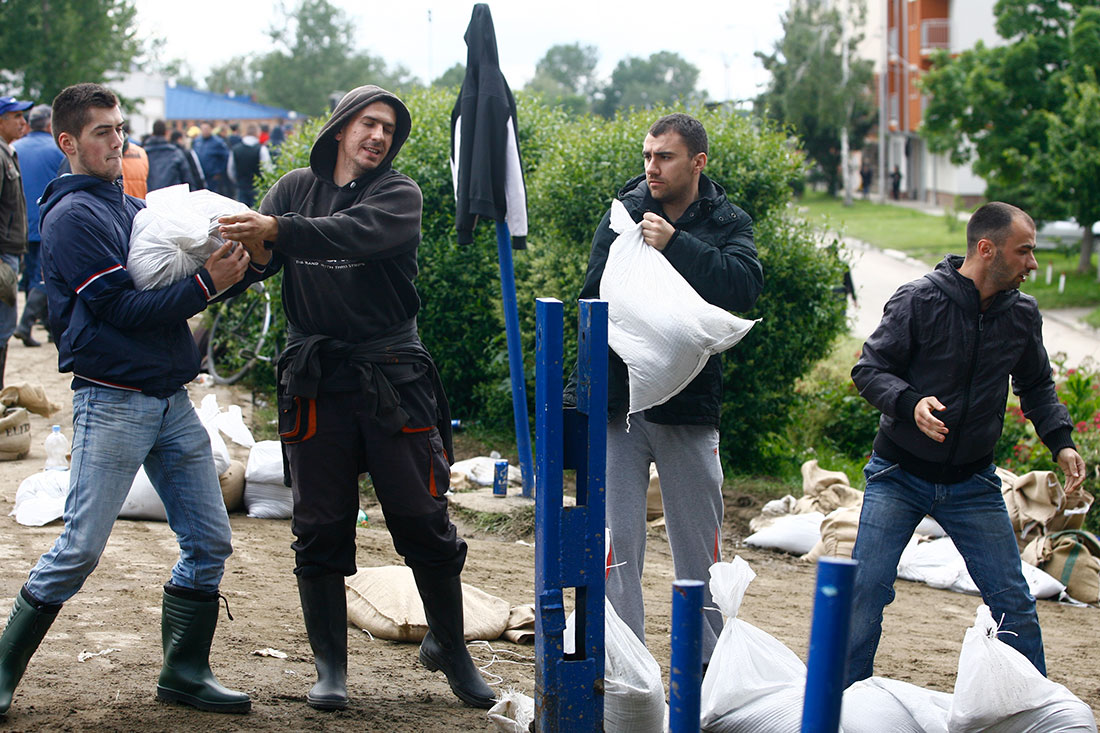
Think of project work as individual sandbags that collectively prevent flooding and drive transformational change. Photo credit: iStock.com/nemar74
3. When evaluating efforts to achieve transformation, we need more than conventional metrics. At first glance one might think that addressing the Gulf dead zone is rather straightforward. It’s widely accepted that excessive nutrients flowing down the Mississippi River are the major contributor to algal growth and declining concentrations of dissolved oxygen. Solving the dead zone simply requires reducing the flow of nutrients from Midwest farm fields, right? If we measure our progress reducing farm nutrient runoff, that will provide a good indicator of progress.
Unfortunately, this approach sees the tip of the iceberg and ignores the 90 percent below water. Agricultural nutrient application may be a clear driver of the Gulf’s dead zone, but we can’t achieve a large-scale reduction of nutrients without recognizing the multiple factors that tend to keep the system as it is—such as federally subsidized crop insurance, capital flows in Midwest agriculture, agricultural supply chain priorities, farmer technical assistance needs, agricultural research and development, cultural norms, and local, state, and federal water management policies.
The scientific method encourages us to isolate variables and observe changes to those variables after interventions. As I am a trained environmental engineer, that’s my fallback approach to driving change. However, I am finding that this reductionist approach is just the opposite of what is required for transformational thinking. We need to embrace the messy, nonlinear world of ambiguous interactions between these different systems and find ways to encourage projects to build off of each other.
4. Transformation makes a diversity of perspectives, approaches, and ways of knowing more important than ever. As mentioned previously, if we accept that we don’t know how to reduce the dead zone, then it follows that we shouldn’t be wedded to any specific approach. Perhaps new technological advances or policies will contribute to a solution, and we should have the humility to recognize that perhaps solutions will be built on approaches outside normal conventions and the dominant culture, such as a new spiritual relationship between people and water. If we had evidence to the contrary—that a specific approach is truly reducing the dead zone—then I would have greater comfort putting many of our proverbial eggs into one basket. Unfortunately, we do not.
5. We tend to only value change that we can see. We need to help people see what lurks beneath the surface. It’s always alarming to look through photos of water pollution from 50 years ago and see the rusted cars, burning rivers, and dying fish and wildlife that were endemic to US lakes and rivers. I’m proud of the collective action that now makes those scenes an anomaly, and in cities such as Minneapolis, riverfronts have shifted from unappealing sites of refuse to desirable residential settings.
In many ways, confronting that type of pollution is easier than what we face today. The Mississippi River’s Lake Pepin is just as stunningly beautiful as ever; a casual observer would never know that enormous flows of sediment from the Minnesota River are filling portions of the lake and burying important fish and wildlife habitat. Similarly, the low-dissolved oxygen levels that create the Gulf’s dead zone occur well off shore and are difficult to observe. How can we do a better job of calling attention to pollution unseen?
6. An honest, powerful, shared narrative leads to action. While messaging, narratives, and an overall communications strategy are recognized as critical for driving change, we also need to help grantees and partners collaborate on a broad, shared narrative.
I am fascinated by a new book by Nobel Prize–winning economist Robert Shiller on narrative economics. Rational behavior is a building block of economic theory—that individuals alter economic behavior on drivers such as interest rates. This is undoubtedly true, but Dr. Shiller contests that the stories we tell ourselves have an underappreciated influence on behavior. When trying to understand drivers of market booms and busts, economists need to pay attention to stories.
Key decisionmakers and the general public don’t necessarily think of the Mississippi River all that often, and when they do, it is frequently in the context of flooding, or a fish kill, or some other adverse event. In those contexts, the solutions put forward tend to be quite reactive and narrow—that the city should build a higher floodwall, or the state should have stricter laws about pollution. We could go much further by having a shared narrative with a positive vision that inspires more people to take action.
7. Following a strategic plan is important, yet it must be paired with personal passion. Great work is done by well-funded organizations with a cadre of experts and clear strategic objectives. And great work is done by individuals that simply have the passion and drive to create something new. Funders should pay attention to both. I’m a big fan of efforts like the Castanea Fellowship, which provides passionate people with training, connections, and financial support to pursue transformative change.
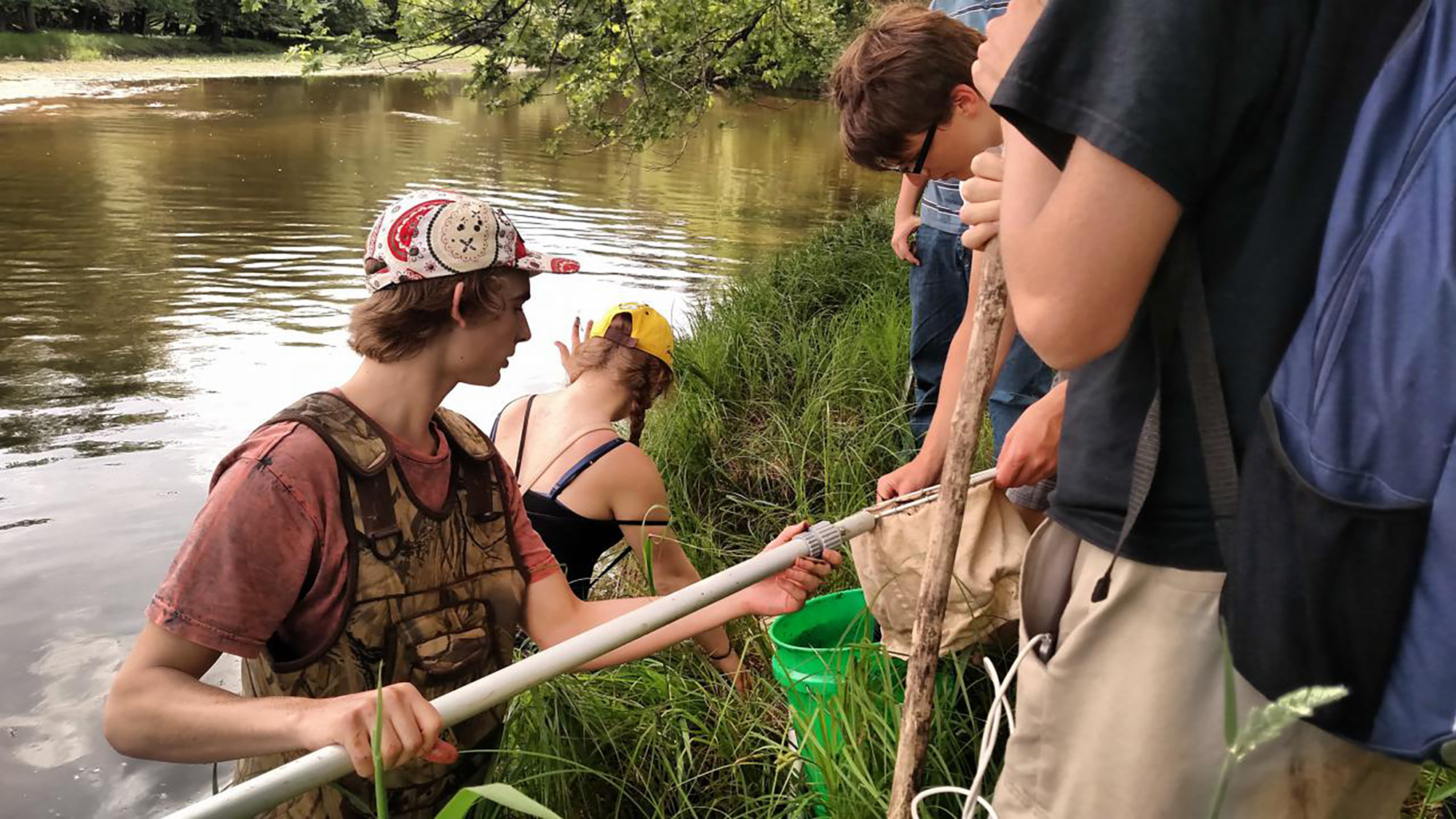
Students from Elk River High School sample invertebrates from a stretch of the Mississippi River. Photo credit: Friends of the Mississippi River
A Hopeful Future
In closing, I leave McKnight’s Mississippi River program hopeful for the future. I readily acknowledge that my younger self from 27 years ago would have been disappointed by the size of the dead zone today and other biological indicators. But I and hundreds of others are much wiser about transformational change because of this journey. We can point to countless water bodies that have been improved. We see new ways of thinking in agriculture that, like the emphasis on soil health, are driving how farmers and communities are adopting practices that improve water quality.
The economic drivers affecting the use of land and water are strong, far stronger than I originally realized. When we put the investments of McKnight and partners and grantees in the context of the 125-million-acre, $75 billion Midwest agricultural industry, it’s no surprise that making a large-scale shift to regenerative practices is slow. Yet we have the advantage of a remarkably tolerant and patient Mother Nature. After more than 100 years of dramatically reengineering Midwest rivers and landscapes, the fact that we maintain moderately healthy soil and water resources is truly a triumph of biology. The essence of patience is that it takes a long time to see improvement, as the Mississippi River has decades of sediment, phosphorus, and pesticides to flush out of its system.
Grantees and partners have improved the Mississippi River and our communities, and taken us a long way on the journey toward a transformed landscape and river system.
I am convinced that at some point in the future—perhaps 25 years from now—we will see a Midwest landscape full of diverse, deep-rooted crops, grasses, and trees. We will see a Mississippi River that is cleaner, more resilient, and a center point of Midwest culture and economy. And when historians review the history of the river and the factors that contributed to the revival, McKnight Foundation will be proud to have supported so many of the organizations that laid the foundation for transformational change.
On behalf of the McKnight board and staff, I extend deep gratitude for the hard work and commitment of McKnight grantees and partners. You have improved the Mississippi River and our communities and taken us a long way on the journey toward a transformed landscape and river system. Thank you, and I hope our paths cross again soon.
If you have questions about the Mississippi River program, please contact Sarah “Sam” Marquardt, program administrator, at smarquardt@mcknight.org.
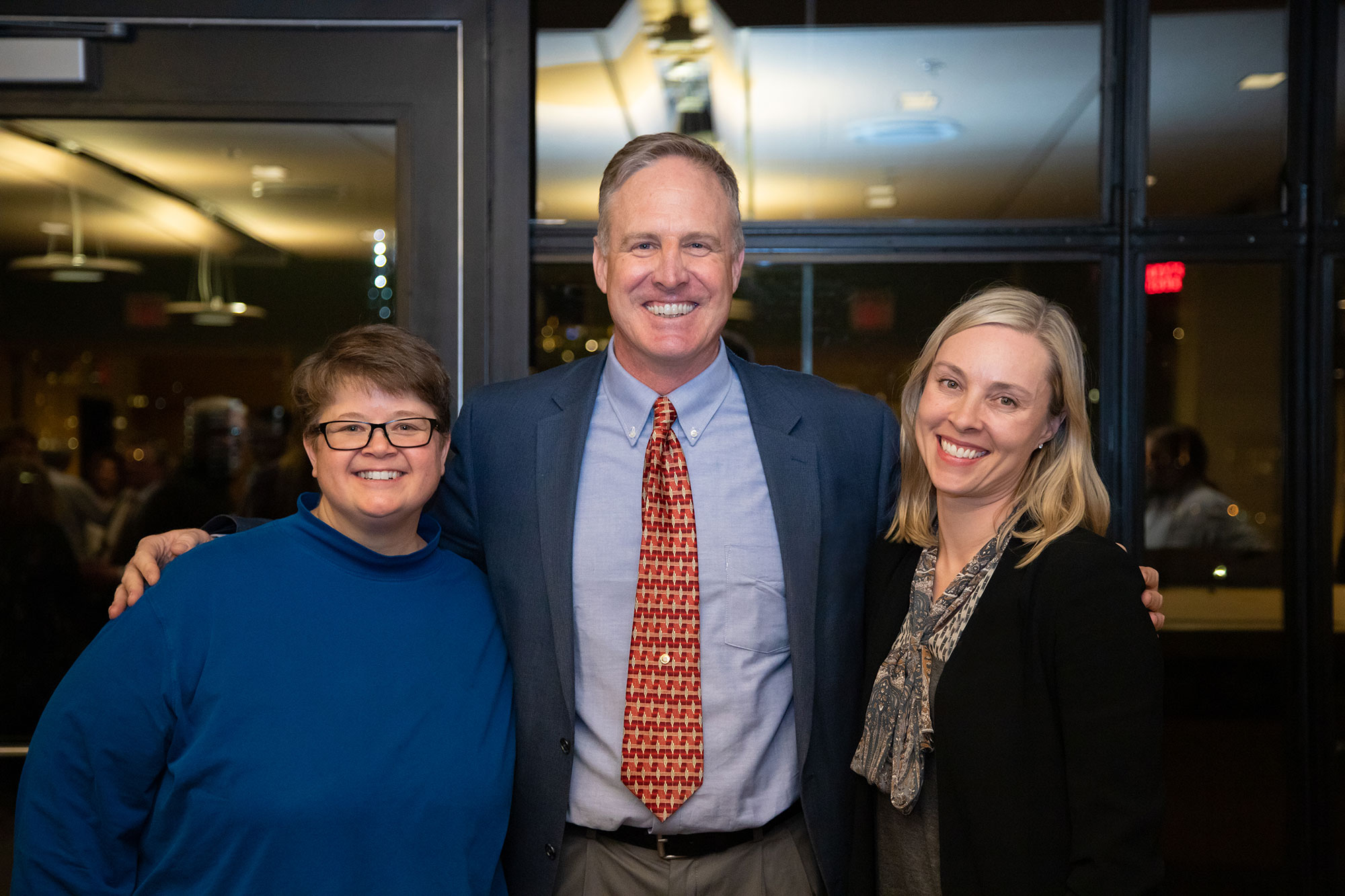
Sarah “Sam” Marquardt, Mark Muller, and Julia Olmstead pose for a photo at an event honoring the grantees of the Mississippi River program. Photo Credit: Molly Miles
